Gods of Taiwan
Ba Jia Jiang (八家將), the Generals

Ba Jia Jiang Performing
Some of the most colourful and dramatic parts of a temple ceremony in Taiwan come courtesy of the Wu Zhen (武陣), military troupes, which come in two main varieties - Ba Jia Jiang (eight generals), and Guan Jiang Shou (官將首). Despite the name, Ba Jia Jiang groups often have up to thirteen members. The origin of these groups is in Fuzhou (福州) in China, from where they spread to Taiwan's Bai Long An (白龍庵) temple, in the south-western city of Tainan . Ba Jia Jiang brings together a number of secondary deities to form a group that serves as a bodyguard for the gods, and a police force for both the living and dead. Ba Jia Jiang are traditionally supposed to refrain from talking, as it is believed that if evil spirits witness them speaking, they will realise that they are mortals acting in the role, and so their effect will be diminished. On reaching a temple, they will perform, walking with high, sweeping steps, and approaching the temple in pairs while the rest of the group mark out a space which should not be intruded upon. They occasionally will also sit, stand or move with firecrackers behind or beneath them, an even more formidable sight with the exploding backdrop.
The members of the Ba Jia Jiang are listed here, in the order in which they stand in the formation.
Xing Ju Ye (刑具爺), God of Weapons of Torture (also known as Shih Yi, 什役)
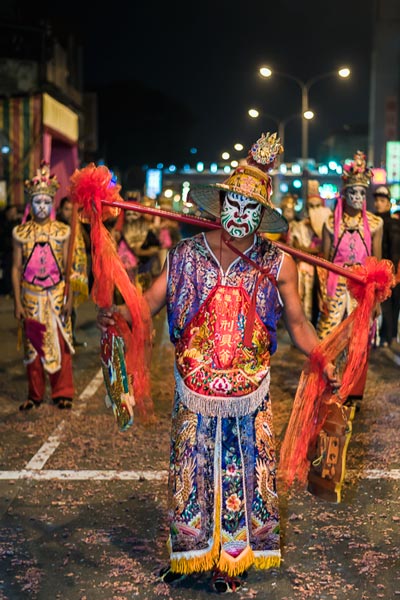
Xing Ju Ye
Xing Ju Ye is first in Ba Jia Jiang's formation, and acts as their leader in the ceremonies. He is easy to recognise due to the weapon hanging from across his shoulders. Unlike the other members, Xing Ju Ye often does not have face paint or special clothes. He calls the troupe to attention after they have taken a break by shaking the chains of his weapon, and performs by squatting to bang his weapon on the ground. He is also unique in walking in the front-centre of the group, whereas the other members form pairs on either side.
Wen Chai (文差) and Wu Chai (武差), the Officials (also known as General Chen, 陳將軍 and General Liu, 劉將軍)
Usually seen next in the formation, following Xing Ju Ye, Wen and Wu Chai are the civilian and military bureaucrats, charged with receiving and passing on orders from the gods, and they are most recognisable for what they carry. Wen Chai carries the Ling Pai (令牌), a symbol shaped like a wide sword, but normally covered in intricate fabric, and Wu Chai carries a flag.
Gan Ye (甘爺) and Liu Ye (柳爺), Administrators of Punishment (also known as General Gan, 甘將軍 and General Liu, 柳將軍)
The next two in the formation, who may also be seen on the front row, are Gan Ye and Liu Ye. They are easily recognised as both of them carry ban bei (板杯), long bamboo sticks. Gan Ye has his face painted half red and half black, representing Ying and Yang, while Liu has swallow patterns. These two are responsible for carrying out sentences, Gan Ye during the day and Liu Ye at night.
Qi Ye (七爺) and Ba Ye (八爺), the Spirit Police (also known as General Xie, 謝將軍 and General Fan, 范將軍)
Already described in the 'Gods of Taiwan' section, these two were best friends whose loyalty to each other, even in death, earned them deification and a role supervising the actions of the living as well as spirits. Qi Ye is easy to identify by the 中 (zhong) character painted on his forehead, he is also generally tall and wearing white. He carries either 魚枷 (yu jia), a weapon shaped like two fish attached at head and tail, or 火籤 (huo qian), a stick of fire. Ba Ye is by contrast generally short, and with black clothing and face paint. He carries 執方牌 (zhi fang pai), a board with good and evil written on it, and may also carry chains.
The Gods of the Seasons
The origins of these gods lie in the Si Xiang (四象), the four images. In ancient China, the sky and earth were divided into four parts, in the case of the earth this corresponded with the directions of the compass. These were represented by four creatures - the Azure Dragon of the East, the White Tiger of the West, the Black Basalt (a combination of tortoise and snake) of the North, and the Suzaku (a phoenix like bird) of the South. These also came to be identified with the seasons - the Spring, Autumn, Winter and Summer respectively. The four Gods of the Seasons are behind the four senior generals in the formation. As well as a creature, they are all represented by a flower or plant, and in keeping with Ba Jia Jiang's role of capturing bad spirits, the Season Gods are tasked with the interrogation (torture is probably more accurate) of Ba Jia Jiang's prisoners. There is some variation in the combination of face paint design, season, and weapon of each god, with different Ba Jia Jiang groups adopting their own systems. A common configuration is given here, the creatures do not match the seasons of the Si Xiang in this case.
Xia Da Shen (夏大神), the God of Summer
Xia Da Shen is perhaps the hardest of the Season Gods to distinguish. His face is said to resemble a turtle pattern, and as with all of the season gods, there is an additional design, in the case of the Summer God it is the plum blossom. However, commonly his face paint uses a flame design, which fits in with his responsibility in the group - to torture the prisoners by burning them. In order to accomplish this, he carries with him a huo pen (火盆) or brazier.
Qiu Da Shen (秋大神), the God of Autumn
Qiu Da Shen is recognisable from the feather-like pattern across both sides of his face, representing the bird, his plant is bamboo. Qiu Da Shen's role in Ba Jia Jiang is to beat the prisoners, and thus he carries a jin gua chui (金瓜錘), mace.
Dong Da Shen (冬大神), the God of Winter
The Winter God's face paint design is that of a tiger, and of a chrysanthemum. His responsibility in the group is to threaten and scare the prisoners, and so he carries she zhang (蛇杖), a snake. In the past, real snakes were used for this, but nowadays it is usually a wooden or metal representation.
Chun Da Shen (春大神), the God of Spring
Chun Da Shen has his face painted in the style of the dragon and the lotus. In the torture of captured spirits, his job is to awaken them if they fall unconscious, and to achieve this he carries a hua lan (花籃), flower basket, from which he takes flowers to throw at the spirits, waking them.
Wen Pan Guan (文判官) and Wu Pan Guan (武判官), the Judges
The final two members of the formation are quite different in appearance from the others, and their presence designates the group as Ten Generals (shi jia jiang, 什家將). Their face paint varies, but is generally less intricate than the other members, and in the case of Wu Pan Guan usually features one dominant colour covering most of the face. Wen Pan Guan is known as the civil judge, and he carries the Sheng Si Bu (生死簿), the Book of Life and Death. Using this, he determines how long people should live. Wu Pan Guan is the military judge, and is armed with a Jian Zhui (鐧錐), a sword or mace, also known as jiu ceng bian (九層鞭), nine lashes.
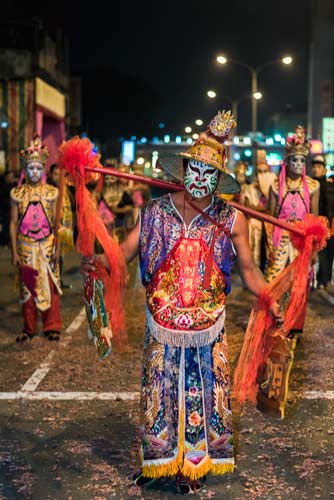
Xing Ju Ye
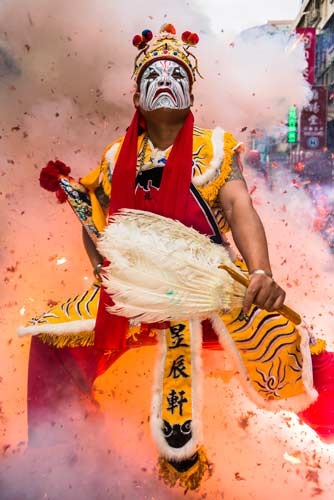
Wen Chai
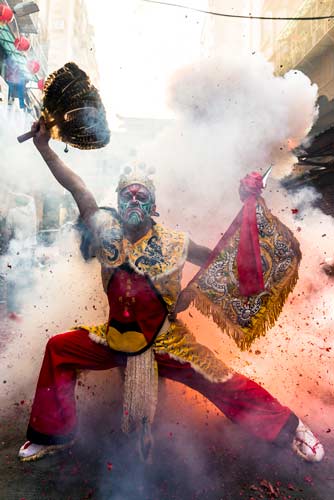
Wu Chai
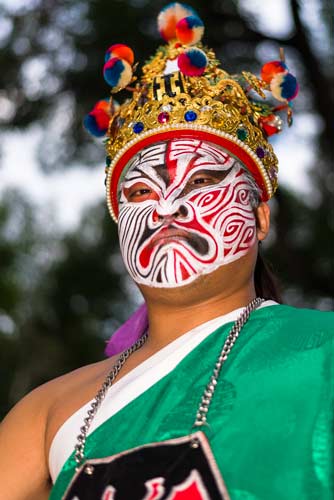
Gan Ye
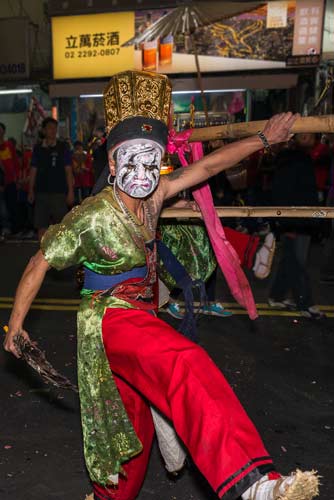
Liu Ye
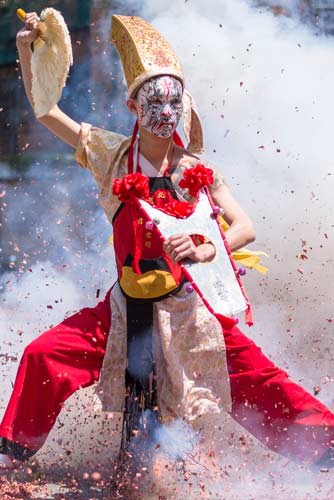
Qi Ye
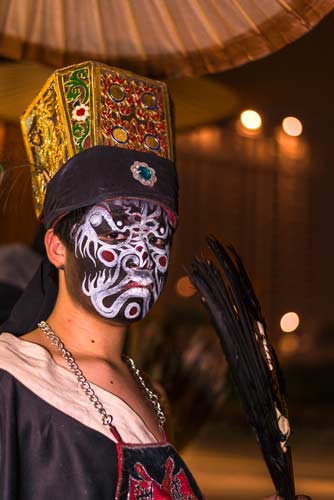
Ba Ye
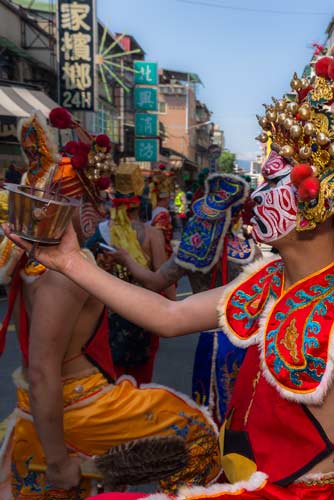
Xia Da Shen
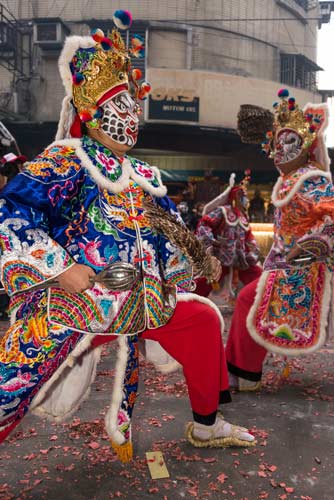
Qiu Da Shen
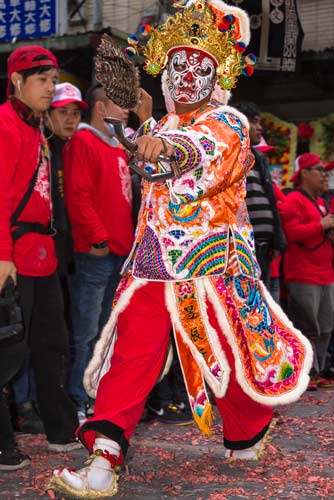
Dong Da Shen
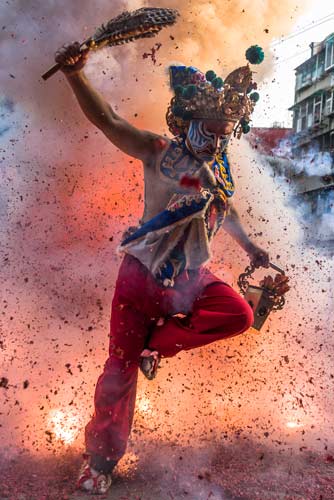
Chun Da Shen
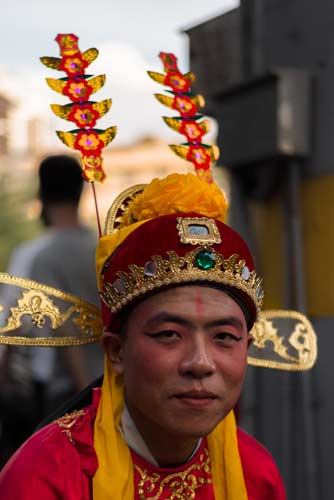
Wen Pan Guan
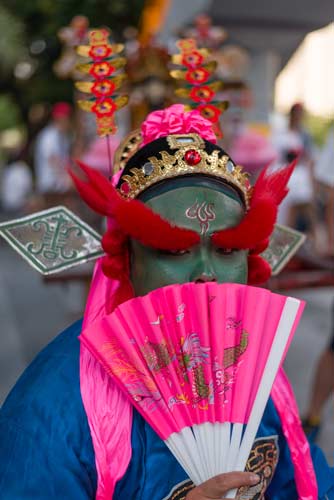
Wu Pan Guan
Previous: Be Bei ANext: Tang Ki
